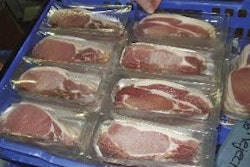.jpg?auto=format%2Ccompress&q=70&w=400)
Checking to make sure that the benefit obtained from vaccination outweighs the cost can be difficult where the target disease expresses itself only in a subclinical form. Some help with the analysis in the case of ileitis has come this year from a project undertaken by a university in Germany.
The team from the veterinary faculty at Ludwig Maximilians University Munich set out to study the economic impact of subclinical ileitis in growing-finishing pigs. Ileitis may result in poor growth rate and decreased feed efficiency as well as diarrhoea, they pointed out, but it exists in both clinical (acute and chronic) and subclinical forms. For detailed information regarding subclinical effects, they chose to perform the project under controlled field conditions on pigs.
Over a period of nine months, they followed trial litters that had been born in three batches spaced three weeks apart. Each batch consisted of at least 60 pigs, which were assigned randomly either to a control group or to one comprising animals that had been vaccinated with Boehringer Ingelheim's vaccine Enterisol Ileitis at three weeks old. The records kept for the groups included their daily individual feed intake, as measured by feeding ad lib through Mannebeck Fitmix stations.
Change in growth rate
Measurements of weight and feed intake started when the pigs were five weeks old and continued until slaughter weight was reached, after 26 weeks. Growth performance during the nursery phase turned out to be similar for both control and vaccinated groups. However, a change in growth rate was seen after pigs were moved to the finishing facility. The researchers describe a confirmation from serology that this changeover had coincided with the onset of infection involving the ileitis agent Lawsonia intracellularis. They say the protection given by vaccination meant the vaccine-group pigs were allowed to develop to their growth potential. This meant a significantly better average daily live-weight gain in the finishing period, at 748 grams/day compared to 692g/day for the controls. Also, their feed conversion of 3.30 signified an improvement from the 3.45 recorded by the control group.
 0811PIGIvaccinationtable1
0811PIGIvaccinationtable1
The dataset ultimately gave a basis for calculating on economics. For this, the team used the price of a 30 kilogram piglet and of the feed used as the two main variable costs that were then deducted from the selling price of the slaughter pig to leave the gross margin. The calculations showed no difference between vaccinated and control pigs for either of these variable cost items.
But pigs from the vaccine group gave a carcase weight that was higher by 5.64kgs and this translated into an extra €9.47 per pig for the selling price. It meant the gross margin being significantly better, increasing €7.60 per pig, as Table 1 reveals. According to the Munich team, it demonstrates what subclinical ileitis can cost even on a unit where management, hygiene and people are focused on disease management. More broadly, it is also a measure of economic impact that can be balanced on other units against the costs involved in vaccinating.
Impact often underestimated
The German conclusions can be compared with some reported earlier this year to the annual pig research days held in France. Here, the investigators had been looking at ileitis vaccination on 42 French units on the basis of average daily weight gain, feed conversion, mortality rate from weaning to slaughter and veterinary costs per sow. These were examined over a minimum of six months before and after vaccination on each site.
Growth rates on these farms were better by 14g/day on average in the over 100,000 vaccinated pigs monitored for the study. This was in the period from 8kg to 115kg. Across the same period, vaccination was associated with an improvement in the pigs' feed conversion of 0.06. Added to these were a 1.7% reduction in death losses and a reduced need for antibiotic treatments that cut veterinary costs by €11.56 per sow. Overall it seemed that these advantages conferred an extra margin of €4.20 per pig produced.
These results (Table 2 ) were presented to the French meeting with the remark that they reinforced the view of ileitis as being often underestimated for its impact, particularly in subclinical form. It is, the presenter declared, an economic disease and one that has emerged especially since antibiotic growth promoters were taken out of European pig feeds. The study also underlined the value of finding a formula by which units and their advisers can determine more clearly whether or not a vaccination strategy is cost-effective.
















